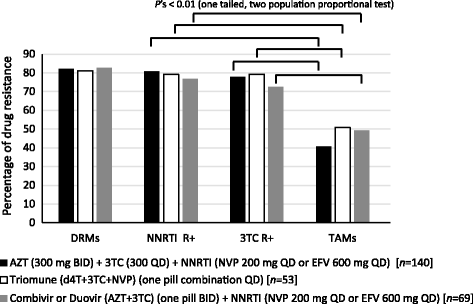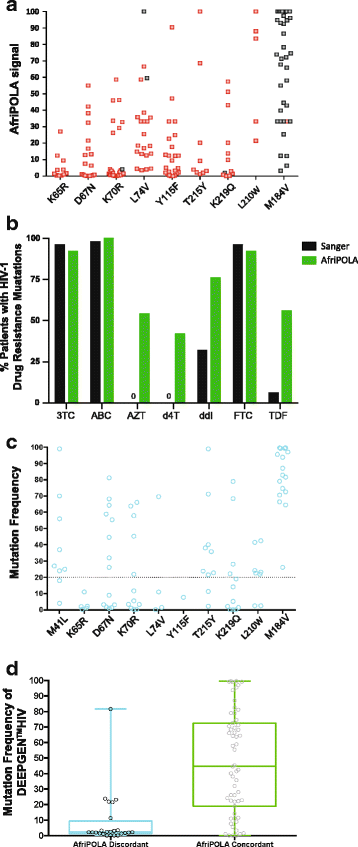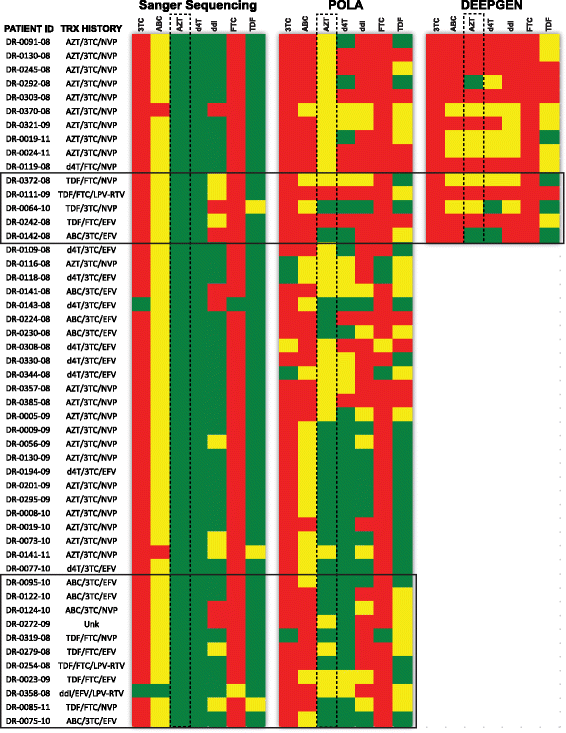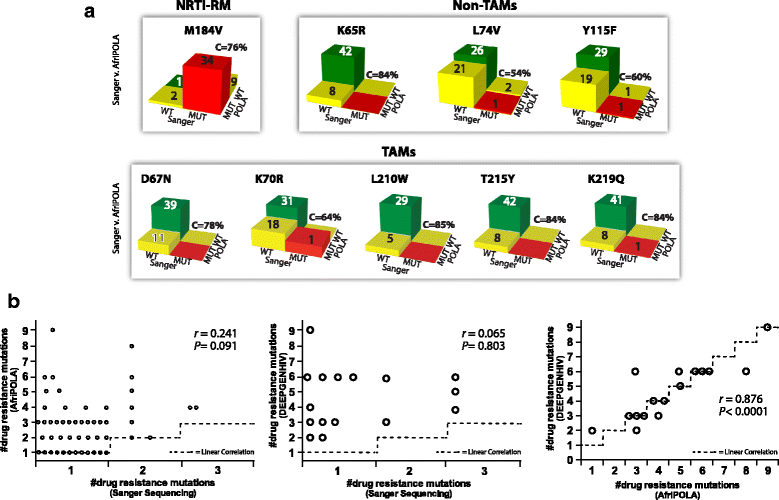Sensitive detection of HIV-1 resistance to Zidovudine and impact on treatment outcomes in low- to middle-income countries
- PMID: 29202874
- PMCID: PMC5716384
- DOI: 10.1186/s40249-017-0377-0
Sensitive detection of HIV-1 resistance to Zidovudine and impact on treatment outcomes in low- to middle-income countries
Abstract
Background: Thymidine analogs, namely AZT (Zidovudine or Retrovir™) and d4T (Stavudine or Zerit™) are antiretroviral drugs still employed in over 75% of first line combination antiretroviral therapy (cART) in Kampala, Uganda despite aversion to prescribing these drugs for cART in high income countries due in part to adverse events. For this study, we explored how the continued use of these thymidine analogs in cART could impact emergence of drug resistance and impact on future treatment success in Uganda, a low-income country.
Methods: We examined the drug resistance genotypes by Sanger sequencing of 262 HIV-infected patients failing a first line combined antiretroviral treatment containing either AZT or d4T, which represents approximately 5% of the patients at the Joint Clinical Research Center receiving a AZT or d4T containing treatment. Next generation sequencing (DEEPGEN™HIV) and multiplex oligonucleotide ligation assays (AfriPOLA) were then performed on a subset of patient samples to detect low frequency drug resistant mutations. CD4 cell counts, viral RNA loads, and treatment changes were analyzed in a cohort of treatment success and failures.
Results: Over 80% of patients failing first line AZT/d4T-containing cART had predicted drug resistance to 3TC (Lamivudine) and non-nucleoside RT inhibitors (NNRTIs) in the treatment regimen but only 45% had resistance AZT/d4T associated resistance mutations (TAMs). TAMs were however detected at low frequency within the patients HIV quasispecies (1-20%) in 21 of 34 individuals who were failing first-line AZT-containing cART and lacked TAMs by Sanger. Due to lack of TAMs by Sanger, AZT was typically maintained in second-line therapies and these patients had a low frequency of subsequent virologic success.
Conclusions: Our findings suggest that continued use of AZT and d4T in first-line treatment in low-to-middle income countries may lead to misdiagnosis of HIV-1 drug resistance and possibly enhance a succession of second- and third-line treatment failures.
Keywords: Antiretroviral treatment; Drug resistance; Uganda.
Conflict of interest statement
Ethics approval and consent to participate
Clinical and virological data were obtained from patient care database at the JCRC under IRB approval (EM10-07) for HIV-1 drug resistance testing.
Consent for publication
Not applicable
Competing interests
E.J.A developed and patented the technology used in AfriPOLA. R.M.G and M.E.Q-M developed DEEPGEN™HIV. There are no further patents, products in development or marketed products to declare.
Figures





Similar articles
-
Comparison of HIV drug resistance profiles across HIV-1 subtypes A and D for patients receiving a tenofovir-based and zidovudine-based first line regimens in Uganda.AIDS Res Ther. 2020 Jan 31;17(1):2. doi: 10.1186/s12981-020-0258-7. AIDS Res Ther. 2020. PMID: 32005262 Free PMC article.
-
K65R in subtype C HIV-1 isolates from patients failing on a first-line regimen including d4T or AZT: comparison of Sanger and UDP sequencing data.PLoS One. 2012;7(5):e36549. doi: 10.1371/journal.pone.0036549. Epub 2012 May 16. PLoS One. 2012. PMID: 22615779 Free PMC article.
-
Antiretroviral resistance patterns and factors associated with resistance in adult patients failing NNRTI-based regimens in the Western Cape, South Africa.J Med Virol. 2011 Oct;83(10):1764-9. doi: 10.1002/jmv.22189. J Med Virol. 2011. PMID: 21837793
-
Stavudine in the face of cross-resistance between HIV-1 nucleoside reverse transcriptase inhibitors: a review.AIDS Rev. 2003 Apr-Jun;5(2):80-6. AIDS Rev. 2003. PMID: 12876897 Review.
-
Quadruple nucleoside therapy with zidovudine, lamivudine, abacavir and tenofovir in the treatment of HIV.Antivir Ther. 2007;12(5):695-703. Antivir Ther. 2007. PMID: 17713153 Review.
Cited by
-
HIV virologic response, patterns of drug resistance mutations and correlates among adolescents and young adults: A cross-sectional study in Tanzania.PLoS One. 2023 Feb 23;18(2):e0281528. doi: 10.1371/journal.pone.0281528. eCollection 2023. PLoS One. 2023. PMID: 36821538 Free PMC article.
-
Synthesis of fluorescent drug molecules for competitive binding assay based on molecularly imprinted polymers.RSC Adv. 2019 Feb 26;9(12):6779-6784. doi: 10.1039/c9ra00422j. eCollection 2019 Feb 22. RSC Adv. 2019. PMID: 35518505 Free PMC article.
-
Characterization of minority HIV-1 drug resistant variants in the United Kingdom following the verification of a deep sequencing-based HIV-1 genotyping and tropism assay.AIDS Res Ther. 2018 Nov 8;15(1):18. doi: 10.1186/s12981-018-0206-y. AIDS Res Ther. 2018. PMID: 30409215 Free PMC article.
-
Genetic landscape for majority and minority HIV-1 drug resistance mutations in antiretroviral therapy naive patients in Accra, Ghana.Heliyon. 2024 Jun 19;10(12):e33180. doi: 10.1016/j.heliyon.2024.e33180. eCollection 2024 Jun 30. Heliyon. 2024. PMID: 39022058 Free PMC article.
-
Determinants of virologic failure among adult HIV patients on first line antiretroviral treatment in Oromia, Central Ethiopia: 2022 a case-control study.AIDS Res Ther. 2024 Jun 24;21(1):42. doi: 10.1186/s12981-024-00625-4. AIDS Res Ther. 2024. PMID: 38915090 Free PMC article.
References
-
- UNAIDS. The HIV and AIDS Uganda Country Progress Report 2014. Geneva, Switzerland. 2014; http://www.unaids.org/sites/default/files/country/documents/UGA_narrativ....
MeSH terms
Substances
Grants and funding
LinkOut - more resources
Full Text Sources
Other Literature Sources
Medical
Research Materials

